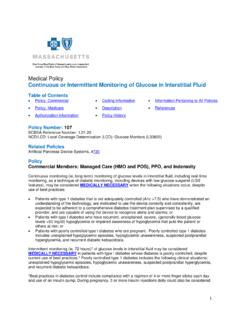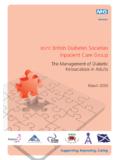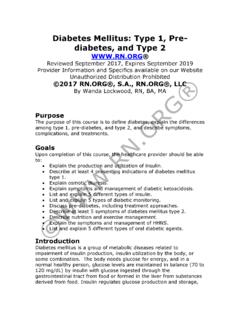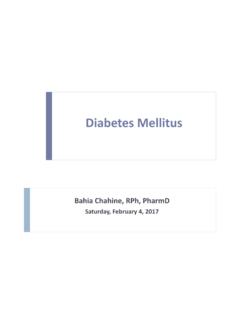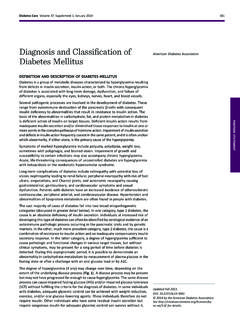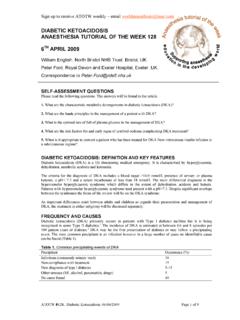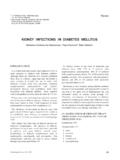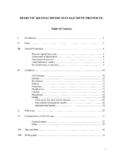Transcription of ICD-10 Diagnosis Codes - Qualigen - Homepage
1 ICD 10 Diagnosis Codes Betsy Nicoletti Simplifying Coding for physicians: Nicoletti, B. (2014). The Field Guide to Physician Coding. Phoenix, MD: Greenbranch Publishing These pages are provided by Qualigen for informational purposes only. Qualigen and/or its representatives are not responsible in any way for the accuracy of this document and recommend reference from the official guide as it pertains to the use of ICD-10 coding. ICD-10 Diagnosis Codes PROSTATE SPECIFIC ANTIGEN (PSA) CPT code : 84153 C61 Malignant neoplasm of prostate Benign essential microscopic hematuria Malignant neoplasm of bladder neck Other microscopic hematuria Secondary and unspecified malignant neoplasm of inguinal and lower limb lymph nodes Hematuria, unspecified Secondary and unspecified malignant neoplasm of intra-pelvic lymph nodes R32 Unspecified urinary incontinence Secondary and unspecified malignant neoplasm of lymph nodes of multiple regions Retention of urine.
2 Unspecified Secondary malignant neoplasm of bone Frequency of micturition Secondary malignant neoplasm of bone marrow Nocturia Secondary malignant neoplasm of genital organs Hesitancy of micturition Carcinoma in situ of prostate Poor urinary stream Neoplasm of uncertain behavior of prostate Feeling of incomplete bladder emptying Neoplasm of unspecified behavior of other genitourinary organs Urgency of urination Obstructive and reflux uropathy, unspecified Staining to void Bladder-neck obstruction Abnormal findings on diagnostic imaging of other abdominal regions, including retroperitoneum Enlarged prostate without lower urinary tract symptoms Abnormal findings on diagnostic imaging of limbs Enlarged prostate with lower urinary tract symptoms Abnormal findings on diagnostic imaging of other parts of musculoskeletal system Nodular prostate without lower urinary tract symptoms Abnormal results of function studies of other organs and systems Nodular prostate with lower urinary tract symptoms Elevated prostate specific antigen [PSA] Inflammatory disease of prostate, unspecified Encounter for screening for malignant neoplasm of prostate Disorder of prostate, unspecified Personal history of malignant neoplasm of prostate Gross hematuria ICD 10 Diagnosis Codes Betsy Nicoletti Simplifying Coding for physicians: Nicoletti, B.
3 (2014). The Field Guide to Physician Coding. Phoenix, MD: Greenbranch Publishing These pages are provided by Qualigen for informational purposes only. Qualigen and/or its representatives are not responsible in any way for the accuracy of this document and recommend reference from the official guide as it pertains to the use of ICD-10 coding. ICD-10 Diagnosis Codes TESTOSTERONE CPT code : 84403 Post procedural testicular hypofunction Other alopecia areata Other testicular hypofunction Enlarged prostate without LUT symptoms (BPH) Other testicular dysfunction Enlarged prostate with LUTS Hormonal imbalance (elevated testosterone) ICD-10 description.
4 Endocrine disorder unspecified Acute prostatitis Female sexual arousal disorder Other specified disorders of prostate (Atrophy of prostate) Sexual dysfunctin not due to a substance or known physiological condition (may not be a covered indication for all payers) Organic azoospermia Decreased libido Organic oligospermia Hypoactive sexual desire disorder Infertility due to extratesticular causes Male erectile disorder Azoospermia due to other extratesticular causes Female orgasmic disorder Alopecia, unspecified Male orgasmic disorder Ophiasis Premature ejaculation ICD 10 Diagnosis Codes Betsy Nicoletti Simplifying Coding for physicians: Nicoletti, B. (2014). The Field Guide to Physician Coding. Phoenix, MD: Greenbranch Publishing These pages are provided by Qualigen for informational purposes only. Qualigen and/or its representatives are not responsible in any way for the accuracy of this document and recommend reference from the official guide as it pertains to the use of ICD-10 coding.
5 ICD-10 Diagnosis Codes CPT code : 84436 THYROXINE; TOTAL CPT code : 84439 THYROXINE; FREE CPT code : 84443 THYROID STIMULATING HORMONE (TSH) CPT code : 84479 THYROID HORMONE (T3 or T4) UPTAKE or thyroid hormone binding ratio (THBR) Tuberculosis of thyroid gland Anemia, unspecified Malignant neoplasm of right ovary Autoimmune lymphoproliferative syndrome [ALPS] Malignant neoplasm of left ovary Other specified disorders involving the immune mechanism, not elsewhere classified Malignant neoplasm of unspecified ovary Congenital iodine-deficiency syndrome, neurological type C73 Malignant neoplasm of thyroid gland Congenital iodine-deficiency syndrome, myxedematous type Malignant neoplasm with pluriglandular involvement, unspecified Congenital iodine-deficiency syndrome, mixed type Secondary malignant neoplasm of other specified sites Congenital iodine-deficiency syndrome, unspecified Secondary malignant neoplasm of unspecified site Iodine-deficiency related diffuse (endemic)
6 Goiter Carcinoma in situ of thyroid and other endocrine glands Iodine-deficiency related multinodular (endemic) goiter Carcinoma in situ of other specified sites Iodine-deficiency related (endemic) goiter, unspecified Benign neoplasm of right ovary Other iodine-deficiency related thyroid disorders and allied conditions Benign neoplasm of left ovary E02 Subclinical iodine-deficiency hypothyroidism Benign neoplasm of unspecified ovary Congenital hypothyroidism with diffuse goiter D34 Benign neoplasm of thyroid gland Congenital hypothyroidism without goiter Benign neoplasm of pituitary gland Hypothyroidism due to medicaments and other exogenous substances Benign neoplasm of craniopharyngeal duct Postinfectious hypothyroidism Neoplasm of uncertain behavior of thyroid gland Atrophy of thyroid (acquired) Neoplasm of uncertain behavior of parathyroid gland Myxedema coma Neoplasm of uncertain behavior of unspecified endocrine gland Other specified hypothyroidism Neoplasm of unspecified behavior of endocrine glands and other parts of nervous system Hypothyroidism, unspecified Vitamin B12 deficiency anemia due to intrinsic factor deficiency Nontoxic diffuse goiter Nutritional anemia, unspecified Nontoxic single thyroid nodule Drug-induced autoimmune hemolytic anemia Nontoxic multinodular goiter Other autoimmune hemolytic anemias Other specified nontoxic goiter ICD 10 Diagnosis Codes Betsy Nicoletti Simplifying Coding for physicians: Nicoletti, B.
7 (2014). The Field Guide to Physician Coding. Phoenix, MD: Greenbranch Publishing These pages are provided by Qualigen for informational purposes only. Qualigen and/or its representatives are not responsible in any way for the accuracy of this document and recommend reference from the official guide as it pertains to the use of ICD-10 coding. ICD-10 Diagnosis Codes (cont.) CPT code : 84436 - THYROXINE TOTAL CPT code : 84439 - THYROXINE; FREE CPT code : 84443 - THYROID STIMULATING HORMONE (TSH) CPT code : 84479 THYROID HORMONE (T3 or T4) UPTAKE or thyroid binding ratio (THBR) Nontoxic goiter, unspecified Disorder of thyroid, unspecified Thyrotoxicosis with diffuse goiter without thyrotoxic crisis or storm Diabetes mellitus due to underlying condition with hyperosmolarity without nonketotic hyperglycemic-hyperosmolar coma (NKHHC)
8 Thyrotoxicosis with diffuse goiter with thyrotoxic crisis or storm Diabetes mellitus due to underlying condition with hyperosmolarity with coma Thyrotoxicosis with toxic single thyroid nodule without thyrotoxic crisis or storm Diabetes mellitus due to underlying condition with ketoacidosis without coma Thyrotoxicosis with toxic single thyroid nodule with thyrotoxic crisis or storm Diabetes mellitus due to underlying condition with ketoacidosis with coma Thyrotoxicosis with toxic multinodular goiter without thyrotoxic crisis or storm Diabetes mellitus due to underlying condition with diabetic nephropathy Thyrotoxicosis with toxic multinodular goiter with thyrotoxic crisis or storm Diabetes mellitus due to underlying condition with diabetic chronic kidney disease Thyrotoxicosis from ectopic thyroid tissue without thyrotoxic crisis or storm Diabetes mellitus due to underlying condition with other diabetic kidney complication Thyrotoxicosis from ectopic thyroid tissue with thyrotoxic crisis or storm Diabetes mellitus due to underlying condition with unspecified diabetic retinopathy with macular edema Thyrotoxicosis factitia without thyrotoxic crisis or storm Diabetes mellitus due to underlying condition with unspecified diabetic retinopathy without macular edema Thyrotoxicosis factitia with thyrotoxic crisis or storm Diabetes mellitus due to underlying condition with mild nonproliferative diabetic retinopathy with macular edema Other thyrotoxicosis without thyrotoxic crisis or storm Diabetes mellitus due to underlying condition with mild nonproliferative diabetic retinopathy without macular edema Other thyrotoxicosis with thyrotoxic crisis or storm Diabetes mellitus due to underlying
9 Condition with moderate nonproliferative diabetic retinopathy with macular edema Thyrotoxicosis, unspecified without thyrotoxic crisis or storm Diabetes mellitus due to underlying condition with moderate nonproliferative diabetic retinopathy without macular edema Thyrotoxicosis, unspecified with thyrotoxic crisis or storm Diabetes mellitus due to underlying condition with severe nonproliferative diabetic retinopathy with macular edema Acute thyroiditis Diabetes mellitus due to underlying condition with severe nonproliferative diabetic retinopathy without macular edema Subacute thyroiditis Diabetes mellitus due to underlying condition with proliferative diabetic retinopathy with macular edema Chronic thyroiditis with transient thyrotoxicosis Diabetes mellitus due to underlying condition with proliferative diabetic retinopathy without macular edema Autoimmune thyroiditis Diabetes mellitus due to underlying condition with diabetic cataract Drug-induced thyroiditis Diabetes mellitus due to underlying condition with other diabetic ophthalmic complication Other chronic thyroiditis Diabetes mellitus due to underlying
10 Condition with diabetic neuropathy, unspecified Thyroiditis, unspecified Diabetes mellitus due to underlying condition with diabetic mononeuropathy Hypersecretion of calcitonin Diabetes mellitus due to underlying condition with diabetic polyneuropathy Dyshormogenetic goiter Diabetes mellitus due to underlying condition with diabetic autonomic (poly)neuropathy Other specified disorders of thyroid Diabetes mellitus due to underlying condition with diabetic amyotrophy ICD 10 Diagnosis Codes Betsy Nicoletti Simplifying Coding for physicians: Nicoletti, B. (2014). The Field Guide to Physician Coding. Phoenix, MD: Greenbranch Publishing These pages are provided by Qualigen for informational purposes only. Qualigen and/or its representatives are not responsible in any way for the accuracy of this document and recommend reference from the official guide as it pertains to the use of ICD-10 coding.
